I love modern cruising but I have also done of a bit of vintage cruising and vacationing where dressing for the day and evenings in vintage attire was expected. Trying to be as accurate as possible begins with a look at 1920s cruise packing lists.
“The first and last rule is to pack little as possible. ” Advice for packing for a cruise in the 1920s is the same as today. What differs are the types of clothing and the occasions they are worn for.
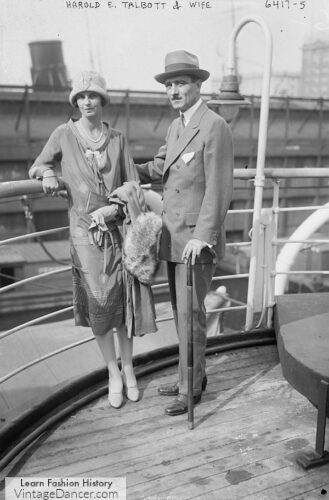
The word cruise wasn’t yet used to describe long distance travel by ship. Instead “passenger ship” or Steamer ship” were the correct names.
The travel guides I found give us a good idea of what the typical man and woman packed for a 1920s cruise in warm or cold climates. It also gives some insight into the schedule, etiquette and entertainment on board that required an outfit change.
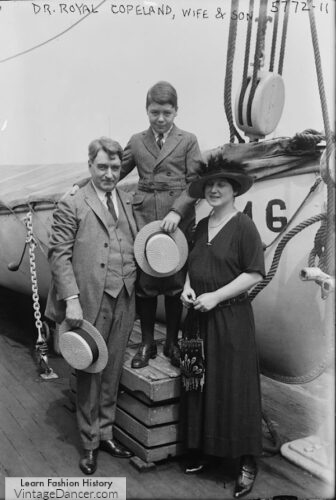
Dr. Royal Copeland, wife and son.
1920s Men’s Cruise Packing Lists
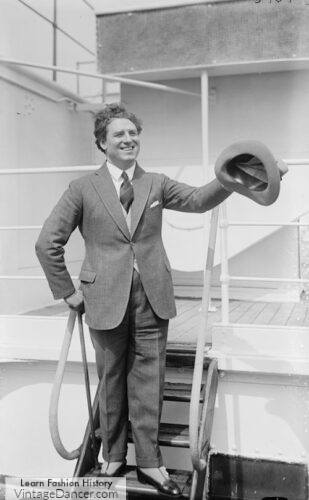
1922 Italian opera singer Giovanni Martinelli on board ship en route to Europe
For a summer trip to Europe:
- 1 Business suit (dark, medium weight)
- 2 Summer suits (at least one dark and not easily soiled)
- 1 Light sweater or cardigan
- 6 Shirts (3 crepe or silk, 2 cotton, 1 light flannel, collar attached, all unstarched)
- 12-15 Collars (semi-soft advisable)
- 6 Sets B. V. D.’s or similar light underwear (Heavier if accustomed to it in summer at home)
- 2 Pairs shoes (comfortable and broken in. Shoes are the one thing you cannot depend upon getting satisfactorily abroad). Rubber soled shoes without heels are useful for deck sports and promenades, but are not indispensable. Two pairs of ordinary shoes should be the irreducible minimum. These should never be brand new, but fairly well broken in before the start.
- Presentable raincoat or waterproof topcoat. A raincoat, useful in almost any clime, will suffice at least the unpretentious man as a bathrobe, afloat or ashore
- 1 Light felt hat, 1 Panama hat (foldable), 1 Cap (medium weight). A cap that can not easily be blown off is essential to male comfort anywhere at sea.
- 12-15 Handkerchiefs
- 4-6 Neckties
- 3 Pajamas (2 silk; 1 cotton or light flannel)
- 2 Pairs garters
- Light slippers 1 Pair
- Washable gloves 6 Pairs
- cotton socks; 3 pairs silk, 3 pairs light wool
- The following things may be very useful, depending on conditions:
- Folding umbrella
- Bathing suit (Or rent one onboard)
- Masquerade costume or supplies to dress up a regular outfit
- Pair low rubbers (Rain shoes / overshoes)
- Silk bathrobe
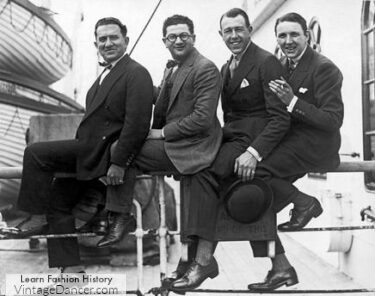
New York, 1925 on the SS Olympic
Other Things to Take:
- Only necessary toilet articles. Soap (in light holder or container)
- Fountain pen Pencil (with extra leads)
- Cheap good watch (leave the diamond-set one at home)
- (Perhaps 1 pair dark glasses or goggles) If you wear eyeglasses, by all means take an extra pair in a solid case.
- 1 Nail and hand brush
- 1 Small clothes brush
- 1 Collapsible drinking cup
- 1 First-aid kit (some would include hot water bottle and medicine case)
- 1 Small sewing kit (“Housewife” at Army-Navy stores; 3 colors of stout thread; black, white and khaki for men; buttons)
- For men, extra set shirt buttons (ladies corresponding equipment)
- Extra shoe-strings Silk, stout cotton or canvas laundry bag with drawstring. (Brown canvas one with lock fine for overflow baggage)
- Diary or notebook.
- Visiting cards (much more important than at home, especially in South America and the Orient)
- Vaccination certificate (may save delay or re-vaccination at some ports)
- 12-24 Baggage tags (Many countries require all baggage to be tagged with the name and address of owner before checking or expressing)
- Camera
- Books
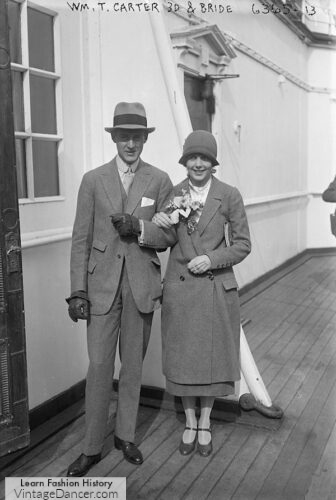
Honeymoon cruise passengers
1920s Women’s Cruise Packing Lists
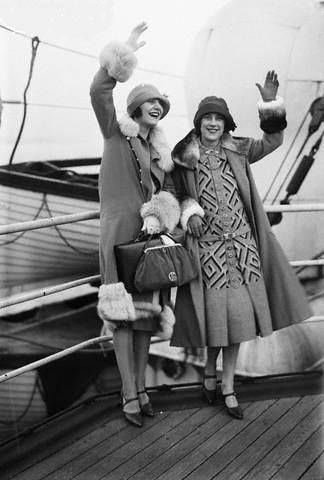
- 1 Traveling dress (dark and silk or similar material)
- 1 Travel suit (light wool or serge)
- 1 or 2 Semi-evening frocks (crepe de chine packs well)
- 2 Washable blouses
- Coat or wrap (medium weight)
- Raincoat or cape (light weight.)
- 1 Soft sweater
- 2 Pairs comfortable shoes, 1 Pair dress shoes
- 12-15 Handkerchiefs
- 6 Pairs silk stockings , 2 Pairs cotton stockings , 2 Pairs light wool stockings
- Sufficient lingerie (crepe de chine or glove silk)
- 1 Pair slippers (preferably waterproof). Bedroom slippers may be of the most compact variety.
- 2 Hats (at least one soft crushable; either both felt or one felt and other Panama; both with considerable brims)
- Sandal rubbers
- Folding umbrella
- 2 Pairs washable gloves
- 1 Silk Kimono. Most ladies will consider a light kimono (robe) necessary. { Bathrooms were a walk down a hall}
- 1 Bathing costume (most ships offer rental bathing suits)
- 1 Masquerade costume
On some cruises “sport clothes” (knickerbockers, etc.,) are much worn. See 1920s sport clothing.
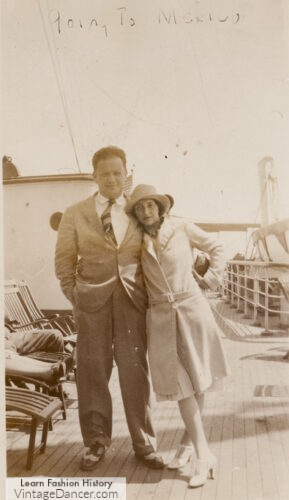
1927 Herman Mankiewicz and his wife on a boat to Mexico
Formalwear- Tuxedos and Evening Gowns
The most questions about vintage cruises I receive are about formalwear. The movies make it look like luxury passenger ships wore white tie tuxedos and fancy evening gowns to dinner every night. The truth was, traveling by land or ship, was an informal affair.
The first class passengers may have dressed up a bit more than 2nd and 3rd classes but they were by no means elaborately dresses. That is for the 1920s. In modern yes they were very fancy.
1924 Scribner’s Handbook of Travel says:
“On shipboard men traveling first class will find it advisable to have a tuxedo (never full dress), and women the corresponding demi-toilette.
On the more luxurious steamers it has become customary to dress for dinner; although full dress either for men or women is never required or desirable on shipboard. However, on the majority of large first-class ships a dinner-jacket would be worn every night, with the exception of the first and last nights. On these nights one’s things are supposed to be packed regardless of the time of sailing or arrival.
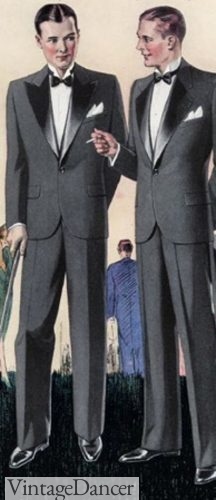
Peak and notch lapel dinner jackets
On the ordinary steamers the men often put on a dark sack suit for dinner, after wearing knickerbockers or sports clothes all day, but in the à la carte restaurant, which is a feature of the larger and more elaborate steamers, the dinner-jacket is usual.
In the dining-saloon ladies wear semi-evening dresses—without hats—for dinner and the same in the restaurant.
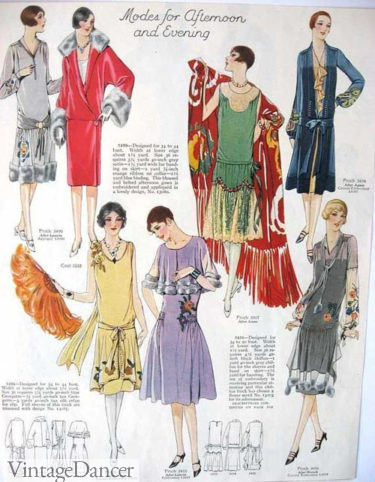
1926 afternoon and evening dresses
The tuxedo will be essential if you are going in for society at all, especially in England, where all “gentlemen” dress for dinner. In that case ladies should have the corresponding costume.
Otherwise, for the hurried trip, these formal clothes may be left with the heavy things, to be picked up again on sailing.”
There was an exception. Some luxury cruises hosted formals balls or fundraiser balls for charity. These would have had women in evening gowns and men in white tie full dress. Longer length “health cruises” would have hosted several evening balls.
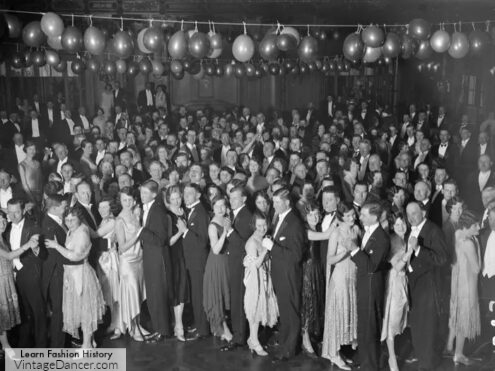
Guests dancing in the ballroom aboard the Berengaria.
What is a dinner jacket vs a tuxedo? White or black tie? These questions are answered in this article for men.
Ladies 1920s evening gowns are discussed here. This article about 1920s afternoon dresses would be more appropriate for cruising.
What are Masquerade Costumes?
Having a fancy dress night where men and women dressed in themed costumes was common on 1920s cruise ships. These fun parties involved at minimum, a mask, and at maximum, entire costumes. Most cruise ships did not specify what theme travelers should dress in leaving the options wide open to animals, famous characters, far away travels, holidays, and historical figures.
Most 1920s masquerade costumes were handmade and repurposed clothes and accessories. This made it possible to transform regular travel clothes into a party costumes without taking up much packing space.
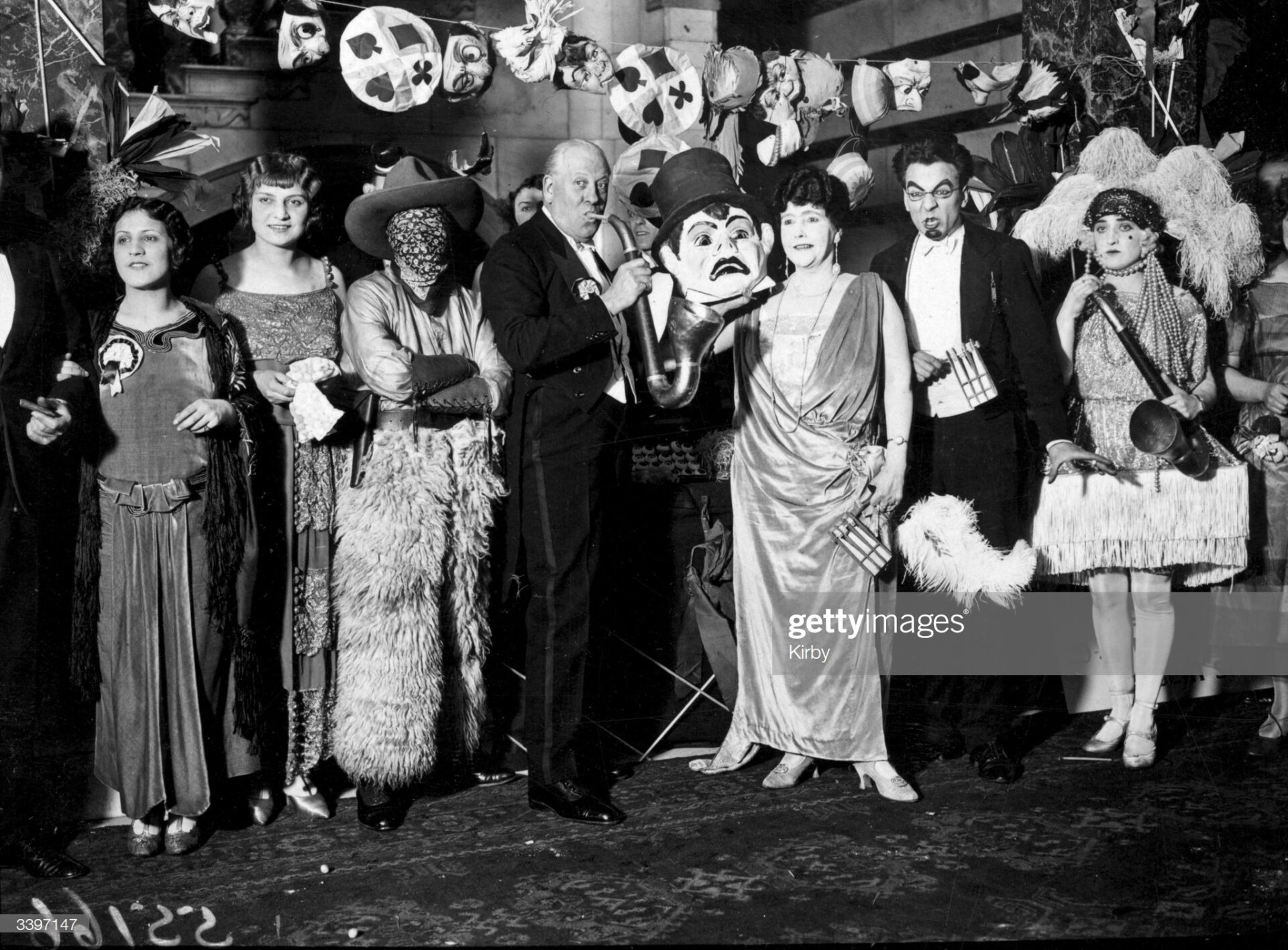
5th February 1924: Revellers from the third Kinema Club Carnival, held at Hotel Cecil. (Photo by Kirby/Topical Press Agency/Getty Images)
Costumes ideas for men: Joker, pirate, clown, Chinese man, sailor, jockey, Greek God, Shakespeare, Magician, Sheik, Uncle Sam, George Washington, Priest, Court Jester, Zorro, Cowboy
Costumes ideas for ladies: Flower, queen of hearts, moon/stars, Egyptian queen, butterfly, Marie Antoinette, pirate, clown, English peasant, Dutch girl, Spanish dancer, peacock, bumble bee, gypsy, Queen of Sheba, Greek Goddess
Packing for Cruise Destinations
“The ship serves the traveler as home from beginning to end, there need be no particular limit. In any other form of travel only a very definite maximum of baggage space is possible.
Across the North Atlantic, on the short route across the Pacific, on any journey north of the Mediterranean in winter, early spring, or late fall, and in Argentine and Chile or New Zealand, or the seas about them during our northern summer, a heavy overcoat and medium heavy winter garments are essential.
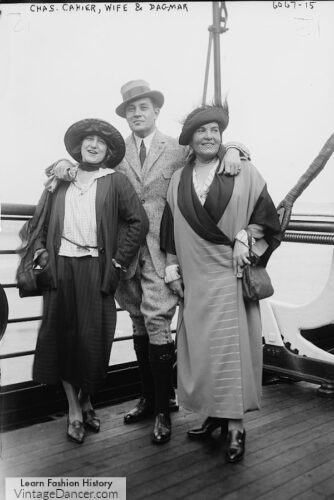
The same will hold for winter in the Mediterranean. A light top- coat or its feminine equivalent is needed for any other trip at sea, unless it is all within a few degrees of the equator. Those who care less for style than for ease of getting about may get along with a fairly heavy sweater instead.
On land, winter clothing is best in all of Europe from about November first to late March, and from October first until the middle of May in Great Britain and Scandinavia.
About the same may be said of Japan, and of China north of Shanghai. Even Canton has a couple of unpleasantly cold winter months. The highlands and all the capitals of western South America, except Santiago, call for at least moderately heavy spring and fall garments at all times. South Africa never gets colder than our April.
The Mediterranean may be likened to our northern states with the four winter months taken out and three or four scorching months intercalated be- tween July and August.
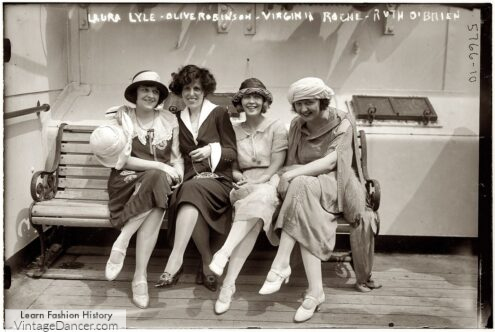
1922 Laura Lyle, Olive Robinson, Virginia Roche, Ruth O’Brien
In the West Indies, almost all the islands of the Pacific, Central America, Panama, and the east coast of South America as far south as Rio and Santos, summer clothing is all that is needed at any time. Even northern Manchuria can be tropically hot in July and August.
Korea is uncomfortably warm for about four months, southern Japan even a month longer than that, Rio de Janeiro, Montevideo, even Buenos Aires, swelter for most of the two months on either side of Christmas and New Year’s. So much for the general weight of the clothing to be selected.
Steamer rugs are best rented along with the steamer chair (these are towels/blankets.)
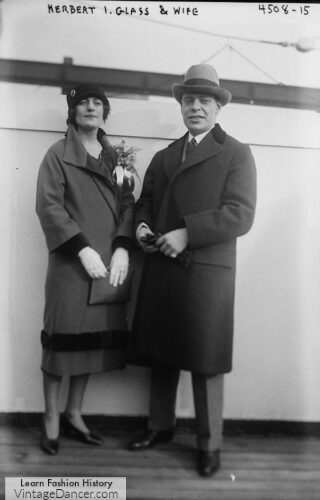
Warm coats onboard worn by Herbert and Blanche Copeland on board Aquitania
On the average summer trip to Europe all outer wraps except a combination top- and raincoat may best be left at or sent on to the port of departure. The exception to this is for those who intend to spend some time in the higher parts of Switzerland.
On cruises in the West Indies or the South Seas, and South America as far south as Rio, white duck is advised (cotton or linen, rather than pongee, etc., since native washerwomen are not always gentle).
In certain places the tropical helmet, and perhaps the colored veil (orange best to prevent sunburn and still not appear lugubrious) are needed. More than twenty years of tropical wandering convinces me that the flannel cholera bands worn by many white people in the tropics are a mere superstition.”
-All About Going Abroad by Harry A. Franck, 1927
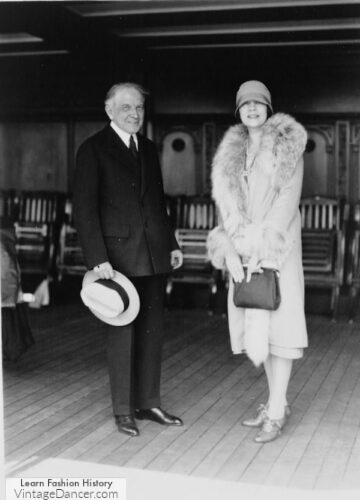
1928 W.C. Durant, motor magnate, & wife
Debbie Sessions has been teaching fashion history and helping people dress for vintage themed events since 2009. She has turned a hobby into VintageDancer.com with hundreds of well researched articles and hand picked links to vintage inspired clothing online. She aims to make dressing accurately (or not) an affordable option for all. Oh, and she dances too.